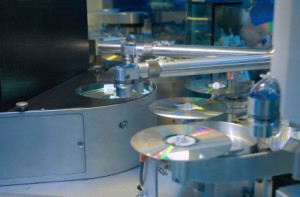Compact Disc’s have become an intrinsic part of modern life. They’re everywhere: They carry our music, our work files, school projects, they come through our letterbox with adverts and hold the software for our computer programs. In short, while twenty years ago they were a luxury, now we would be lost without them.
But haven’t you ever wondered how CD manufacturing works? How are these discs put together and what are the resources that go into them?
The answer is not as complex as you might imagine: There are five main layers to a CD. However, because in the process of CD manufacturing, each layer must be produced separately so the manufacturing process has many stages and is quite detailed.
The first layer on a CD is thick and manufactured from Polyvinyl Chloride (PVC), a soft, clear polycarbonate plastic. Interestingly, this layer makes up 99% of the CD the other four layers making up only 1% of it! Thus, this layer is very important, serving two purposes: First, it protects the data layer from scratches and secondly, like the lenses in spectacles, it helps the laser beam to focus on the data itself. This layer of the CD is manufactured by feeding small granules of PVC into a hydraulic press where they are heated until they melt. The molten plastic is then forced by a screw into a mould cavity and it takes on the round, CD shape. The plastic is then allowed to cool and harden and a robotic metal arm removes it and stamps the hole into the middle. This is called the ‘stacking ring’.
Next comes the ‘data layer’, perhaps the most complicated part of CD manufacturing. The data on a CD consists of many pits and lands, bumps which go up and down and represent either a one or a zero. They work in a way very similarly to binary on a computer or simple on and off switches in a light. These pits and lands spiral out from the centre of the CD and are read and interpreted by a laser. Unlike the vinyl, however, the data is read from the inside to the outside on a CD and not the other way around. To place these very important pits and lands on the CD during the manufacturing process, a glass master copy of the data is made in the image of how the CD will look, using a powerful laser and something akin to a CD writer. The glass master is then pressed against a metal disc to create a negative image of the CD, making a mould, or ‘press’. (Hence the term ‘to press a CD’, or ‘CD pressing‘.) Once the press has been made, the clear PVC disc is pushed against it, so that the data is imprinted on the surface of the disk itself.
This part of the process of CD manufacturing is a little different if the CD is a recordable one. In this instance instead of a data layer, a photosensitive dye is applied. This dye, when exposed to certain light which can be emitted from the lasers in CD writers, creates the impression of a pit. Similarly, a re-recordable disk uses a dye, but a slightly different one which allows the laser to polarize the layer back and forth between a pit and a land.
The next stage in CD manufacturing is to place a thin layer of metal onto the PVC disc. The metal is usually silver or aluminium but it can also be made from gold or other metals. It is applied to the PVC disc on top of the data using a process called sputtering, which means that a surface, here the disk, is bombarded with small atoms of a substance, in this case the metal. This makes the CD act as a mirror, reflecting the CD player’s laser back to the reader. It’s also this that gives the underside of a CD its shiny appearance.
The CD manufacturing process is nearly done now and the last major physical change to the disc takes place: A thin coating of lacquer applied in a ring around the centre of the CD and spread out to the edges by spinning the disk very fast. The edges are also coated with lacquer. This coating ensures the safety of the data and the foil, which are the most important parts of the CD to protect.
All the other parts of the CD manufacturing process are almost purely cosmetic, including the final layer, the application of the label which contains information about what is on the disk, who made it and possibly a few graphics, especially if it is a music CD or a film.
The disk is now ready to be printed and packed and it is only after this that we, the consumers, see the disk! It is very rare that we actually appreciate the time and energy that goes into manufacturing a CD. But now, next time you use one (which these days will probably be very soon) you can look at it and know exactly how it was made!
